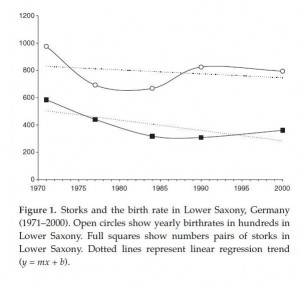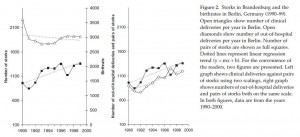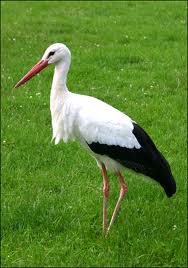Two different theories exist concerning the origin of children: the Theory of Sexual Reproduction (ThoSR) and the Theory of the Stork (ThoS)….
Nowadays, many people believe in the theory of reproduction, simply because they have been taught this theory in school … A number of the world’s leading scientists are still in favour of ThoS. Some recent scientific work (1997–2001) has shown new evidence for ThoS.
So begins a (fairly) recent paper by Thomas Höfer, Hildegard Przyrembel, and Silvia Verleger in the journal Paediatric and Perinatal Epidemiology. [1]
I confess that I have long been skeptical of the Theory of the Stork, based on the ability of the Inuit to survive with a very small local stork population. It seems clear to me that storks are not absolutely necessary for delivery of children, at least in a Paleolithic culture eating a marine-rich diet.
Yet, I admit to being over-skeptical at times. Due to this personality quirk I have entirely missed out on the widely reported benefits of orange juice [2], aspirin [3], eggshells [4], 8-to-12-egg breakfasts [5], ice baths [6], and intentional overeating [7].
As a scientist, I feel obliged to follow the evidence wherever it leads. So let’s look at this new evidence for the Theory of the Stork.
Correlation of births with storks
It’s long been known that human birth rates are correlated with the local stork population. This is true longitudinally (over time) as well as latitudinally (distance from the equator). The latitudinal evidence is too obvious to show, it is why Arctic and Antarctic populations of both storks and humans are so small, but the longitudinal evidence may surprise many.
Here are representative longitudinal data from Lower Saxony, Germany:
The strength and weakness of the data are apparent. The correlation is clear, yet the correlation does not quite reach statistical significance. It seems the number of children per stork fluctuates from year to year.
What new evidence have Höfer et al generated? It is an insight so startling in its simplicity that it’s a wonder no one thought of it earlier. They noticed that the introduction of air-conditioning and central heating, resulting in the closing of windows at hospitals, decreased the correlation of births with storks. In their words:
It is a well-known fact that storks are never seen in hospitals, but scientists have disregarded this simple truth in their studies. [1]
They therefore reproduced the epidemiological studies, this time using only out-of-hospital deliveries. The correlation with local stork population is much improved. Here is the data for Brandenburg, Germany, the state that contains Berlin:
On the left is the correlation of total deliveries with stork population. The correlation is quite poor; perhaps Berlin hospitals are particularly forbidding to storks. On the right is the correlation of out-of-hospital deliveries with stork population. The correlation is much, much stronger.
Höfer et al conclude:
Medical interventions may be able to replace the stork. They are particularly necessary in hospitals where storks do not come. Our study clearly shows that ThoS has to be restricted to out-of-hospital deliveries. [1]
The implication is clear: if you want your baby to be delivered in the traditional way, by stork, do not enter a hospital.
Conclusion
It looks like obstetrical science is heading toward a hybrid theory, in which both medical deliveries in hospitals and stork deliveries contribute to the human birthrate.
To conclusively resolve remaining conflicts between the Theory of Sexual Reproduction and the Theory of the Stork, randomized clinical trials will be required.
The obvious design would be to randomize two sets of couples. The intervention group would reside on a stork farm, while the control group would reside on a chicken farm. Extra-long artificial beaks would have to be fitted to the chickens to make the subjects “blind” to their group. The technology already exists to conduct such a trial. Here is an intervention group animal:
And a control animal being fitted with artificial beak:
But funding agencies will never step forward with the millions of dollars required for such a trial as long as Big Hospital controls obstetrical research. For the foreseeable future we will be limited to epidemiological evidence.
I personally find the new epidemiological evidence in favor of the Theory of the Stork quite as compelling as the epidemiological evidence against red meat and white rice. However, until clinical trials have been performed, I think it is prudent for pregnant women to continue to utilize medical delivery services, and to rely upon storks only in emergencies.
References
[1] Höfer T et al. New evidence for the theory of the stork. Paediatr Perinat Epidemiol. 2004 Jan;18(1):88-92. http://pmid.us/14738551.















Recent Comments